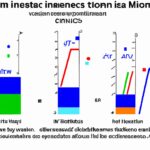The Gini coefficient is a measure of income inequality within a population. It ranges from 0 to 1, with 0 representing perfect equality and 1 representing extreme inequality. To calculate the Gini coefficient, you need to follow a specific formula. First, arrange the incomes of the population in ascending order. Next, calculate the cumulative percentages of the population and the cumulative percentages of income. Then, plot these values on a graph. Finally, use the graph to calculate the area between the Lorenz curve and the line of perfect equality. This area divided by the area under the line of perfect equality gives you the Gini coefficient.
Table of Contents
- Alternative measures of income inequality
- Definition of Gini coefficient
- Formula for calculating Gini coefficient
- Interpretation of Gini coefficient
- Limitations of Gini coefficient
(How to Calculate the Gini Coefficient)
The Gini coefficient, a commonly used measure of income inequality, provides insight into the distribution of wealth within a population. Calculating the Gini coefficient involves a simple formula that captures the disparity between individuals or groups.
To start, arrange the income or wealth data in ascending order. Divide the population into equal-sized groups, also known as quintiles or deciles. Calculate the cumulative percentage of income or wealth held by each group.
Next, construct the Lorenz curve, a graphical representation of the income or wealth distribution. Plot the cumulative percentage of the population on the x-axis and the cumulative percentage of income or wealth on the y-axis.
To find the Gini coefficient, subtract the area under the Lorenz curve from the area under the line of perfect equality. The line of perfect equality represents a scenario where each individual or group has an equal share of income or wealth.
Divide the result by the area under the line of perfect equality to obtain the Gini coefficient. The coefficient ranges from 0 to 1, with 0 indicating perfect equality and 1 representing extreme inequality.
Intuitively, a lower Gini coefficient suggests a more equitable distribution of income or wealth, while a higher coefficient indicates greater inequality.
Understanding the formula for calculating the Gini coefficient enables policymakers, researchers, and organizations to evaluate and address inequalities within a society. It serves as a valuable tool in the pursuit of economic and social justice.
Alternative measures of income inequality
Alternative measures of income inequality provide additional insights into the distribution of wealth within a society. While the Gini coefficient is a commonly used measure, there are other methods that can capture different aspects of income inequality.
One alternative measure is the Palma ratio, which focuses on the income share of the richest individuals compared to the poorest. This ratio highlights the concentration of wealth at the top and provides a different perspective on inequality. By emphasizing the extremes, the Palma ratio can reveal the disparities that may be masked by other measures.
Another alternative measure is the Atkinson index, which takes into account society’s preferences for inequality. This index incorporates a social welfare function that weighs the well-being of individuals at different income levels. By capturing societal preferences, the Atkinson index provides a nuanced view of inequality that goes beyond simple income comparisons.
The Theil index is yet another alternative measure that considers the distribution of income across different subgroups within a population. This index takes into account both within-group inequality and between-group inequality, making it particularly useful for analyzing inequality in diverse societies. By capturing differences between groups, the Theil index can highlight disparities that may be overlooked by other measures.
It is important to consider these alternative measures alongside the Gini coefficient to gain a comprehensive understanding of income inequality. While the Gini coefficient provides a useful summary measure, it can be limited in capturing the complexities of inequality. By utilizing alternative measures, policymakers and researchers can gain a more nuanced understanding of the distribution of wealth.
In conclusion, alternative measures of income inequality offer valuable insights into the distribution of wealth within a society. The Palma ratio, Atkinson index, and Theil index provide different perspectives that complement the Gini coefficient. By considering these alternative measures, policymakers can make more informed decisions to address income disparities and promote a fairer society.
Definition of Gini coefficient
The Gini coefficient is a measure of income inequality within a population. It is often used to determine the distribution of wealth among individuals or households. The coefficient ranges from 0 to 1, with 0 indicating perfect equality and 1 indicating extreme inequality.
To calculate the Gini coefficient, a Lorenz curve is used. The Lorenz curve is a graphical representation of the cumulative income distribution. It plots the cumulative percentage of the population on the x-axis and the cumulative percentage of income on the y-axis.
The Gini coefficient is derived from the Lorenz curve. It is calculated by dividing the area between the Lorenz curve and the line of perfect equality by the total area below the line of perfect equality. The result is a decimal value between 0 and 1.
A Gini coefficient of 0 represents perfect equality, where every individual or household has the same income. On the other hand, a Gini coefficient of 1 signifies extreme inequality, where one individual or household possesses all the income.
The formula for calculating the Gini coefficient is relatively straightforward. It involves dividing the area between the Lorenz curve and the line of perfect equality by the total area below the line of perfect equality. This ratio provides a measure of inequality within the population.
The Gini coefficient is widely used by economists, sociologists, and policymakers to assess income disparities and measure the effectiveness of policies aimed at reducing inequality. It helps to evaluate the impact of taxation, welfare programs, and economic policies on the distribution of wealth.
Understanding the Gini coefficient is crucial for policymakers as they strive to create a more equitable society. By analyzing income inequality, governments can design policies to address the needs of those less fortunate and work towards achieving a fairer distribution of wealth.
In conclusion, the Gini coefficient is a valuable tool for measuring income inequality within a population. Its calculation is based on the Lorenz curve and provides a decimal value between 0 and 1. A higher Gini coefficient indicates greater inequality, while a lower coefficient signifies a more equal distribution of wealth. Policymakers can use this information to address income disparities and create a more equitable society.
Formula for calculating Gini coefficient
The Formula for Calculating Gini Coefficient is a method used to measure income inequality within a population. It is a widely accepted tool in the field of economics and social sciences. The Gini coefficient ranges from 0 to 1, with 0 representing perfect equality and 1 indicating extreme inequality. This formula allows economists and policymakers to quantify and compare income disparities across different regions and countries.
To calculate the Gini coefficient, one must first gather data on the income distribution within the population. This data typically includes income levels for various individuals or households within the group being studied. Once this data is collected, the following steps can be taken to calculate the Gini coefficient.
First, sort the income data in ascending order, starting from the lowest income level to the highest. Then, assign ranks to each income level, with the lowest income receiving a rank of 1, the second lowest a rank of 2, and so on. After assigning ranks, calculate the cumulative percentage of total income for each rank. This can be done by dividing the sum of the incomes of the first n individuals by the total income of the entire population, where n is the rank being analyzed.
Next, calculate the Lorenz curve, which is a graphical representation of the income distribution. To do this, plot the cumulative percentage of total income on the y-axis and the cumulative percentage of population on the x-axis. A line of perfect equality would start from the origin and ascend at a 45-degree angle.
Finally, calculate the area between the Lorenz curve and the line of perfect equality. This area represents the Gini coefficient and can be calculated using integral calculus or by dividing the area into small trapezoids and summing them up. The resulting number is the Gini coefficient, ranging from 0 to 1.
Interpretation of the Gini coefficient is straightforward. A lower coefficient signifies a more equal distribution of income, while a higher coefficient indicates greater inequality. This information can be used to analyze the impact of policies and programs aimed at reducing inequality and promoting economic growth.
In conclusion, the formula for calculating the Gini coefficient is an essential tool in measuring income inequality. By quantifying and comparing income disparities, economists and policymakers can gain valuable insights into the distribution of resources within a population. This information allows for the development of targeted interventions to address inequality and promote a more just and equitable society.
Interpretation of Gini coefficient
The Gini coefficient is a widely used measure of income inequality that helps to interpret and understand the distribution of wealth within a society. It is calculated based on the Lorenz curve, which plots the cumulative percentage of total income received by the cumulative percentage of the population.
The Gini coefficient ranges from 0 to 1, where 0 represents perfect equality and 1 represents extreme inequality. A Gini coefficient of 0 means that every individual in a society has an equal share of the total income, while a coefficient of 1 signifies that one individual has all the income and everyone else has none.
Interpreting the Gini coefficient can provide valuable insights into the level and nature of inequality within a given society. For example, a lower coefficient indicates a more equal distribution of income, suggesting a fairer society where individuals have similar economic opportunities.
On the other hand, a higher Gini coefficient suggests greater income inequality, with wealth concentrated in the hands of a few individuals or groups. Such a society may face social and economic challenges, as disparities in wealth can lead to social unrest and hinder overall economic growth.
However, it is essential to understand the limitations of the Gini coefficient. It provides a single summary measure of inequality without capturing the full complexity of the distribution of income. Therefore, it is crucial to rely on other indicators and context-specific information to obtain a comprehensive understanding of inequality.
Additionally, the Gini coefficient does not capture other dimensions of inequality, such as access to education, healthcare, or opportunities for social mobility. Therefore, policymakers and researchers often use the Gini coefficient in conjunction with other indicators to gain a more nuanced understanding of inequality and devise appropriate policy interventions.
In summary, the interpretation of the Gini coefficient offers valuable insights into income inequality within a society. By understanding the level and nature of inequality, policymakers can devise targeted interventions to address socioeconomic disparities and promote a more equitable society. However, it is essential to consider the limitations of this measure and complement it with a broader set of indicators for a comprehensive assessment of inequality.
Limitations of Gini coefficient
The Gini coefficient is a widely used measure of income inequality that captures the extent to which the distribution of income within a society deviates from perfect equality. While this formula provides valuable insights into economic disparities, it is important to recognize its limitations in order to fully understand its implications.
One limitation of the Gini coefficient is that it only considers relative inequality, not absolute levels of poverty or affluence. For example, two countries may have the same Gini coefficient, indicating similar levels of income inequality, but one country may have significantly higher overall income levels. This means that the Gini coefficient alone cannot provide a complete picture of a society’s economic well-being.
Another limitation is that the Gini coefficient does not capture other dimensions of inequality, such as access to education, healthcare, or social opportunities. These factors are crucial in determining overall social welfare, but they are not accounted for in the Gini coefficient calculation. Therefore, relying solely on the Gini coefficient may lead to an oversimplified understanding of inequality.
Further, the Gini coefficient assumes that all income is equally distributed within each income group, which may not always be the case. Within-group disparities in income distribution can significantly impact the overall measure of inequality. Therefore, the Gini coefficient may underestimate or overestimate inequality in certain circumstances.
Additionally, the Gini coefficient is sensitive to changes in the middle-income earners, sometimes referred to as the “middle squeeze” effect. The coefficient can remain constant even if there are significant changes in income among the lowest or highest earners. This can limit its usefulness in capturing shifts in inequality that may occur within specific income groups.
Furthermore, the Gini coefficient does not account for differences in the cost of living across regions or countries. This means that it may not accurately reflect disparities in real purchasing power or the ability to meet basic needs across different areas.
In conclusion, while the Gini coefficient is a valuable tool for measuring income inequality, it is important to be aware of its limitations. Understanding these limitations can help policymakers and researchers gain a more comprehensive understanding of inequality and its implications for society.












